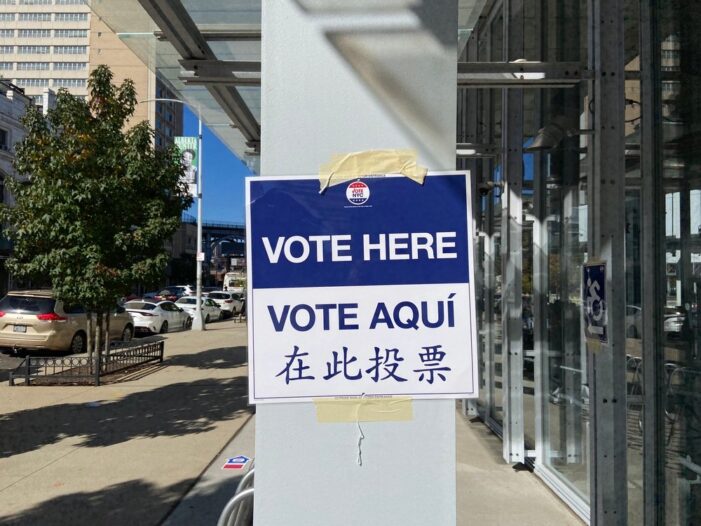New York, NY USA – October 29, 2022: A Vote Here Vote Aqui voting sign in English, Spanish and Chinese at an early voting location at Columbia University in New York City. (Shutterstock)
By Rachel Holliday Smith, THE CITY
For the last two election cycles, New York City voters have used ranked choice voting, which was approved by 73% of voters in 2019 to vote in local primaries.
Voters will use ranked choice voting (RCV) once again in the June 27, 2023 primary for most of the offices on their ballots, with one important exception: RCV is used only for municipal elections like City Council, but not in district attorney races, which are technically state offices. This year, DAs are on the ballot in The Bronx, Queens and Staten Island.
Like the 2021 mayoral primary, there are likely to be contests this year with long lists of candidates where ranked choice-related pacts may emerge. In that primary, for example, Kathryn Garcia and Andrew Yang formed a late alliance encouraging their respective supporters to rank the other one “second” on the ballot for mayor.
There likely will be more deals like that this year as each one of the City Council’s 51 seats is on the ballot this year. More than a dozen seats have four or more people vying to win it: One north Bronx district already includes nine candidates, according to THE CITY’s analysis of campaign fundraising records as of late March.
Again, ranked choice is used only for primaries, not general elections; come November, we’ll go back to using traditional, top-choice-only voting.
The switch to RCV on primary ballots appears fairly simple to the eye. Here’s what you need to know before heading to the polls:
What is ranked choice voting, and how does it work?
Instead of choosing only one favorite candidate, voters rank up to five candidates in each race.
If one candidate gets more than 50% of the first-place votes, that person wins. If no candidate reaches that majority, however, instead of an expensive run-off election between the top two vote-getters, the ranked-choice method sorts out the best-preferred candidate for the most people.
If your top pick has the fewest first-choice votes among all voters, that candidate is eliminated from the race, and all of those voters’ second-choice picks are counted up. That process continues, with one candidate removed each round, until one candidate has more than half of the first-place votes.
Here’s an explanation of that in less than 90 seconds by Minnesota Public Radio ahead of the 2013 mayoral race in Minneapolis. Voters there approved the use of ranked choice voting in 2006.
Here are a few more good sources for information about ranked choice voting:
- The city’s nonpartisan Campaign Finance Board (CFB) prepared an explanation of RCV with images of a sample ballot
- Vox.com wrote a detailed article about what ranked choice voting is and how it works ahead of New York City’s ballot measure in 2019 where voters approved the change.
Why use ranked choice voting? What does it change?
While the changes on the physical ballot are small, the implications for candidates and elections are huge.
The system favors candidates who are more broadly supported in the electorate, and research has shown ranked choice voting tends to make campaigns less negative and encourages more women and nonwhite candidates to run.
The method also saves taxpayer money by eliminating the need for runoff elections.
How has ranked choice worked out in NYC’s elections so far?
The first big test for RCV in the city happened during the 2021 primary season and, overall, experts say it went smoothly. It continued to have detractors, however — including now-mayor Eric Adams — who claimed that a lack of education about the new system disenfranchised non-English-speaking and older voters.
Adams won the 2021 primary after eight rounds of ranked choice vote tabulations. He received 30.7% of first-round ballots, but ultimately prevailed with about 8,400 votes — or roughly one percentage point of all votes cast — more than former city Sanitation Commissioner Garcia.
A lawsuit challenging RCV’s use in city elections was not successful, and an effort to repeal the election method has not moved forward.
One of RCV’s goals is to give voters more choices, and boost how many ballot selections influence the final outcome. In that way, the voting method appears to be a success.
After the 2021 primary, the civic group Citizens Union found that just under 15% of voters across the city had inactive or “exhausted” ballots, meaning that all candidates chosen by a voter were eliminated in the final round of ranked choice voting.
By comparison, in 2013’s Democratic mayoral primary, 33% voters cast ballots for candidates who didn’t make it to the top two spots. The decrease in exhausted ballots held true for almost every race in the primary, according to the analysis.
What else should I know about ranked choice voting?
Readers like you asked our newsroom 63 questions about RCV during the 2021 election and we spoke to voting experts and RCV advocates to answer the most common queries.
That guide includes answers to questions like:
- Do I have to pick my top five, or can I just pick one candidate?
- What happens if I skip a ranking?
- Which candidates benefit the most from RCV?
- And: If I hate a candidate, should they be my last rank, or left off the list completely?
The answer to that last question, from Sean Dugar – then the education campaign program director at Rank the Vote — is good to keep in mind for all city voters:
“Never vote for someone you hate,” Dugar said.
“We like to say: the first choice is the candidate you love. Your second choice is the candidate that you like. Your third and fourth choice is the candidate you like slightly less. And your fifth choice is the candidate you can stand,” he added.
Here’s a good way to think about it: You really don’t like orange soda. If your friend was going to the store and asked you what kind of drink you want, you might tell them to pick up a lime seltzer, and if they don’t have lime seltzer, to get a root beer, or iced tea or apple juice. But you’d never tell them to get you an orange soda if all those other choices aren’t for sale.
“If you don’t want that person in office, you don’t vote for them,” Dugar said.
This story was originally published on [March 23, 2023] by THE CITY.”





